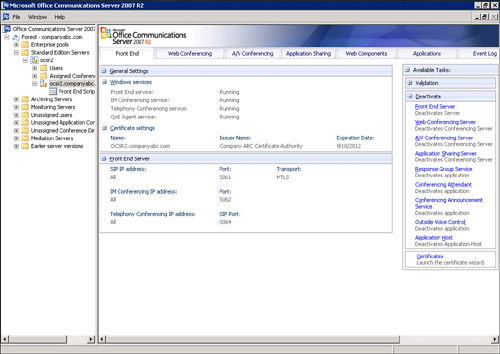Automatic Client Upgrade
Administrators
are encouraged to make the client upgrade process as simple as possible
for end users. There are two recommended methods:
The Lync client can be packaged and pushed by SCCM
similar to most other programs. There are no caveats other than this
process also uninstalls any legacy clients, including OCS Communicator.
The Client Version Policy has an option to either refer the user to a
URL where the new client can be installed or to push the client
directly from any web location accessible from the client. This option
is configured in the Lync Server Control Panel under the Clients tab in
the Client Version Policy section.
Note
Ensure that the location chosen by the administrator is available to users both internally and externally.
Decommission Process
The
final step is to delete the BackCompatSite in the Lync Topology Builder
and decommission the OCS 2007 R2 Servers. Follow the steps that follow
to perform the decommission process:
1. | Open the Topology Builder tool on the Lync Front End Server.
|
2. | Select the BackCompatSite.
|
3. | Click Delete in the right Action pane.
|
4. | A warning pops up saying the site is not empty. Click OK to delete it anyway.
|
5. | Republish the topology by clicking the Lync Server 2010 item in the left pane. Then click Publish Topology in the right Action pane.
|
6. | Click Next to begin the process.
|
7. | Ensure that it finishes successfully and the BackCompatSite object is deleted from the topology.
|
8. | Log in to the OCS 2007 R2 Server.
|
9. | Open the OCS 2007 R2 MMC.
|
10. | Expand the forest and then choose either Enterprise Pools or Standard Edition Servers, whichever is appropriate.
|
11. | Expand the pool and select the first Server. Then expand the Deactivate menu on the right side of the MMC as shown in Figure .

|
12. | The administrator deactivates all services for each Front End Server. Start at the bottom of the list and select Application Host to deactivate the application host.
|
13. | Click Next four times to complete the wizard and begin the process. Note that the administrator might need to check the Force Deactivation of Application Host box if applications still run on the OCS 2007 R2 Server. When the process is complete, click Finish to close the wizard.
|
14. | Expand the Deactivate menu again and select Application Sharing Server.
|
15. | Click Next three times to go through the wizard. Click Finished when it is completed.
|
16. | Expand the Deactivate menu again and select A/V Conferencing Server.
|
17. | Click Next three times to go through the wizard. Click Finished when it is completed.
|
18. | Expand the Deactivate menu again and select Web Conferencing Server.
|
19. | Click Next twice to go through the wizard. Click Finished when it is completed.
|
20. | Expand the Deactivate menu again and select Web Components Server.
|
21. | Click Next three times to go through the wizard. Click Finished when it is completed.
|
22. | Expand the Deactivate menu again and select Front End Server. Ensure that the Conferencing Directory is deleted. It might need to be manually deleted from the Assigned Conference Directories menu item.
|
23. | Click Next four times to go through the wizard. Click Finished when it is completed.
|
24. | Perform steps 11–23 for all servers in a multiserver deployment.
|
25. | This
process deletes the server and pools for a Standard Edition deployment.
For an Enterprise pool deployment, right-click the pool and select Remove Pool.
|
26. | The final step is to uninstall the OCS 2007 R2 binaries from the server and power it off.
|
After these steps are complete, the OCS
2007 R2 infrastructure is fully decommissioned, and administrators can
focus on tuning their Lync Server 2010 environment.